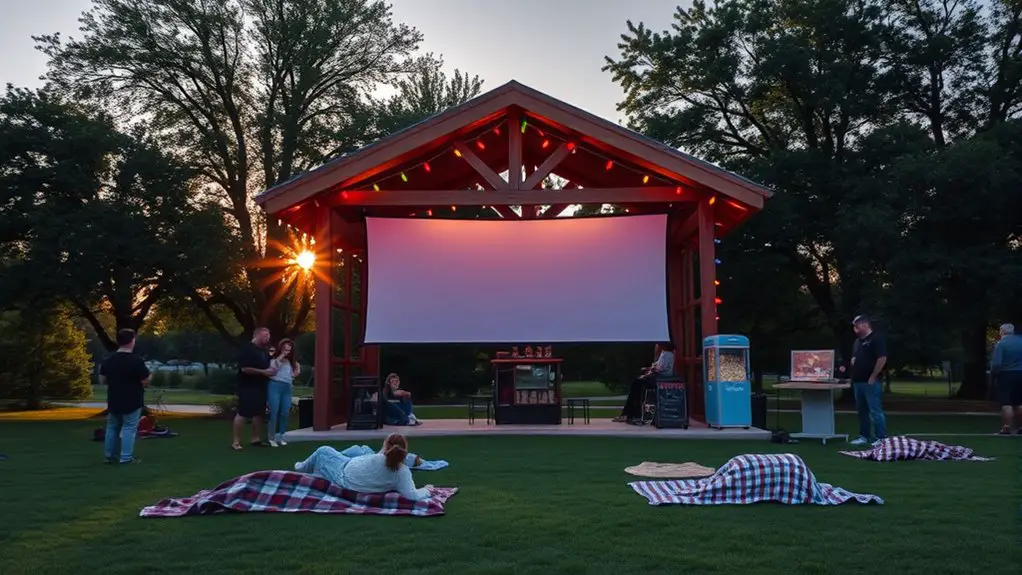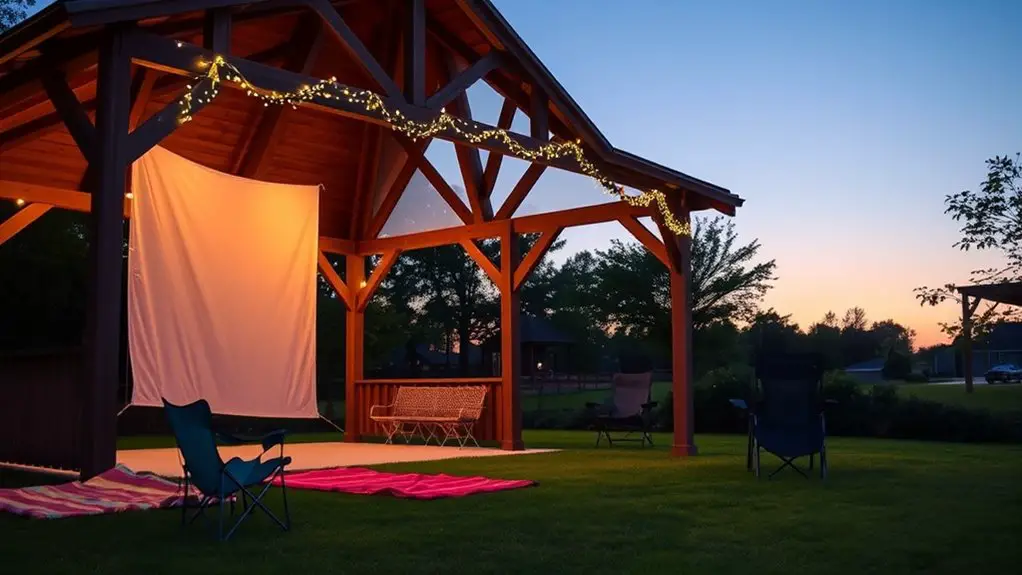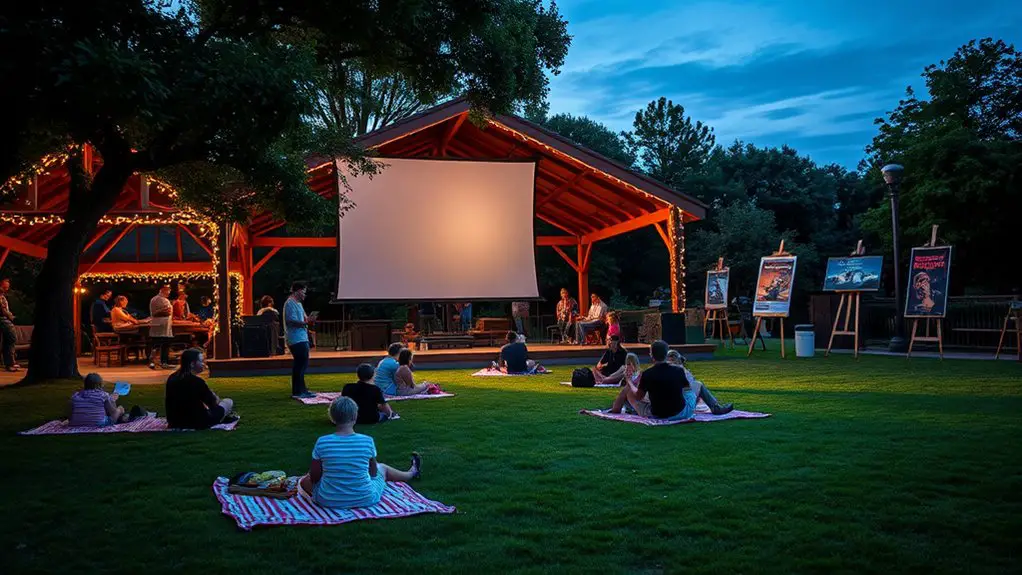To set up a movie screening in a community gazebo, start by choosing a well-located spot that’s accessible and has good visibility. Next, select a portable sound system and a suitable projector, ensuring the screen is properly set up for ideal viewing. Organize seating arrangements to maximize comfort and accessibility. Pick a movie that resonates with your audience, and promote the event through social media. If you need extra guidance, there’s more to discover on enhancing your event experience.
Choosing the Right Location for Your Screening

When you’re planning a movie screening, choosing the right location can make all the difference in the audience’s experience. First, consider the weather conditions. An outdoor venue like a community gazebo can provide a charming atmosphere, but you’ll want to check the forecast. If rain or high winds are predicted, you might need a backup plan. Next, think about parking availability. Confirm there’s enough space for your audience to park comfortably. If parking is limited, provide clear directions to nearby alternatives or encourage carpooling.
Additionally, think about accessibility for all attendees. An easily reachable location can enhance attendance and create a sense of community. Finally, evaluate the sound and visibility of the area. Choosing a spot that minimizes distractions guarantees everyone can fully enjoy the film. With these considerations in mind, you’ll set the stage for a memorable screening experience.
Selecting the Appropriate Equipment
Selecting the appropriate equipment is essential for ensuring your movie screening goes off without a hitch. First, consider your audio quality. A portable sound system with good speakers will amplify the dialogue and enhance the overall experience. You might want to invest in wireless microphones if you’re planning to introduce the film or host a discussion afterward.
Next, think about lighting considerations. Natural light can be unpredictable, so plan for some portable lights to illuminate the area without creating glare on the screen. A few strategically placed LED lights can help set the mood while maintaining visibility for your audience. For outdoor settings, consider using energy-efficient LED lights to enhance ambiance while being mindful of electricity consumption.
Lastly, check that your projector is suitable for outdoor use, ensuring it can handle the ambient light. With the right equipment, you’ll create an enjoyable atmosphere that lets everyone immerse themselves in the film. Remember, the goal is to create a seamless experience for your community.
Setting Up the Projection Screen

When setting up the projection screen, choosing the right screen size and type is essential for an enjoyable viewing experience. You’ll also need to secure the setup to prevent any interruptions during the screening. Let’s explore how to make these decisions effectively.
Choosing the Right Screen
How can you guarantee that your movie screening delivers the best visual experience? Choosing the right screen is essential. Consider these factors:
- Screen Size: Make certain it fits your gazebo and is large enough for your audience to see from a distance. A good rule of thumb is to have a screen that’s at least one-third the distance from the screen to the audience.
- Material Type: Opt for a screen made of high-quality, reflective material. This guarantees vibrant colors and sharp images, even in low light.
- Portability: If you plan on moving the setup, look for a lightweight, easy-to-assemble option that can withstand outdoor conditions.
With these tips, your screening will be a hit!
Securing the Setup
Once you’ve chosen the right screen, it’s time to secure the setup for your projection. First, make certain the screen is stable by anchoring it properly, using weights or stakes to prevent any wind-related issues. Next, consider your audience’s comfort; position seating at a safe distance. It’s essential to address potential liabilities, so don’t forget to prepare liability waivers for attendees, protecting you against unforeseen incidents. Additionally, securing insurance coverage for the event can provide peace of mind and financial protection. Finally, check the area for any hazards like uneven ground or low-hanging branches that could pose risks. With these steps, you’ll create a safe and enjoyable screening environment that respects everyone’s freedom to enjoy the film.
Organizing Seating Arrangements
When organizing seating arrangements for your movie screening, consider the layout options that best fit your audience and venue. It’s important to think about accessibility, ensuring everyone can enjoy the experience comfortably. By addressing these factors, you’ll create an inviting atmosphere for all attendees.
Seating Layout Options
Choosing the right seating layout for your movie screening can greatly enhance the audience’s experience. When considering different seating styles, prioritize audience comfort to guarantee everyone enjoys the show. Here are three layout options to choose from:
- Rows: Arrange chairs in straight lines facing the screen. This traditional layout maximizes space and keeps everyone focused on the film.
- Circles: Create a more intimate atmosphere by placing chairs in a circular formation. This style encourages conversation before and after the movie.
- Lounge: Use blankets and cushions scattered around the gazebo. This relaxed setup allows for a cozy vibe, perfect for family or friends.
Select a layout that best fits your audience, and you’ll create a memorable viewing experience for everyone!
Accessibility Considerations
As you organize your seating arrangements, it’s essential to prioritize accessibility for all attendees, making certain everyone can enjoy the screening comfortably. Here’s a quick reference table to help you plan:
| Seating Type | Wheelchair Access | Sensory Considerations |
|---|---|---|
| Front Row | Yes | Bright colors, sounds |
| Middle Row | Yes | Balanced lighting |
| Back Row | Limited | Dimmers for comfort |
| Grass Seating | Yes | Soft textures |
| Reserved Areas | Yes | Quiet zones available |
When arranging seats, make certain pathways are clear for wheelchair access and consider sensory considerations for those with sensitivities. By thoughtfully planning your layout, you create an inclusive atmosphere, allowing everyone to experience the joy of cinema.
Picking the Perfect Movie

How can you guarantee your movie screening captivates your audience? Picking the perfect movie is essential, and it starts with understanding genre selection and audience preferences. Here are three key considerations:
- Know Your Audience: Assess the demographics of your community. Are they families, teens, or adults? This will guide your movie choice.
- Consider the Season: Seasonal themes can enhance the experience. For example, a light-hearted comedy works well in summer, while a cozy drama fits colder months.
- Engage Your Audience: If possible, involve your community in the selection process. You can create a poll or survey to find out what genres or specific films resonate with them.
Promoting Your Movie Night
While selecting the right movie is essential, promoting your movie night effectively can make all the difference in attracting an audience. Start by leveraging social media platforms like Facebook, Instagram, and Twitter. Create engaging posts featuring movie details, eye-catching visuals, and event logistics. Don’t forget to use relevant hashtags to widen your reach!
Additionally, consider forming local partnerships with nearby businesses or community organizations. They can help spread the word by sharing your event on their channels or displaying posters in their establishments. Collaborating with local influencers can also boost visibility and attract a diverse crowd.
Lastly, engage with your community by encouraging them to share the event with friends and family. Offer incentives like snacks or giveaways for those who RSVP or bring a friend. By using these strategies, you’ll create excitement and guarantee a fantastic turnout for your movie night!
Preparing for the Event Day
Once you’ve successfully promoted your movie night, it’s time to focus on the logistics for the event day. Create a clear event timeline to guarantee everything runs smoothly. Assign specific volunteer roles so everyone knows their responsibilities. Here’s a simple checklist to follow:
- Setup Team: Arrive early to set up the screen, seating, and sound equipment.
- Refreshment Crew: Prepare snacks and drinks, guaranteeing a fun atmosphere for attendees.
- Ushering Staff: Greet guests, direct them to seating, and provide any necessary information.
Make certain to communicate with your volunteers beforehand to clarify their roles and confirm timing. This way, everyone’s on the same page, and you can focus on enjoying the event. With a solid plan, your movie screening in the gazebo will be a memorable experience that fosters community spirit and freedom!
Frequently Asked Questions
What Permits Do I Need for a Community Movie Screening?
Before you can enjoy a film under the stars, you’ll need film licensing and public liability permits. They guarantee everything’s legal and safe, letting you focus on the joy of community and cinema together.
How Do I Handle Bad Weather on Screening Day?
If bad weather strikes, have a rain contingency plan ready. Consider moving to an alternative venue, like a community center, where you can still enjoy the screening without worrying about the elements disrupting your fun.
Can I Charge Admission for the Event?
You can’t make an omelet without breaking eggs. If you’re considering charging admission fees, set reasonable ticket pricing. Ascertain your community knows the purpose, as transparency can foster support and encourage attendance for your event.
What Safety Measures Should I Consider for the Audience?
You should prioritize audience comfort by ensuring adequate seating and shade. Establish clear emergency procedures, including evacuation routes and first aid availability, to create a safe environment where everyone can enjoy the event freely.
How Do I Engage the Community Before the Event?
You’d think ignoring your neighbors would work, but community outreach and social media are your best bets. Create engaging posts, host discussions, and invite feedback to spark excitement and guarantee everyone feels included in the upcoming event.

